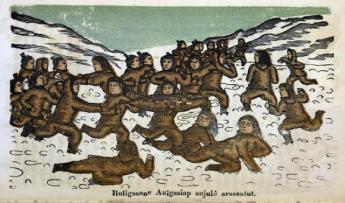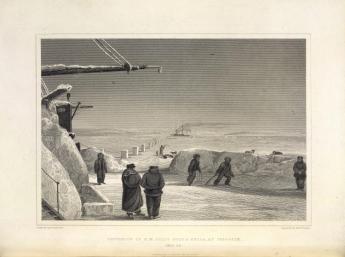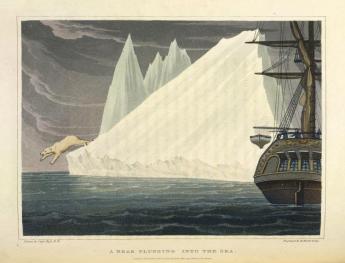Antiquarian Booksellers' Association Ash Rare Books
Lines in the Ice

By Laurence Worms
I really rather enjoy these smaller-scale exhibitions (i.e. the free ones) at the British Library. You get a distinct sense that the bright young curators have just been left to get on with it, without undue interference from the message-spinners and marketing types. The latest, Lines in the Ice: Seeking the Northwest Passage, which opened a few days ago, is excellent and demands a visit.
The Arctic has long held us in thrall, from the classical legends of Ultima Thule – “six days’ sail north of Britain … no longer any proper land nor sea nor air, but a sort of mixture of all three of the consistency of a jellyfish in which one can neither walk nor sail”, according to Pytheas – to our more immediate modern concerns of global warming. The new exhibition, curated by Philip Hatfield from the BL’s Canadian Collections and Tom Harper from the Map Library, tells the long story of European (and especially British) engagement – and in particular the long search for a transformational trading route to the riches of the East – the North-West Passage.
It has all that I like in an exhibition. Lots of books and maps, obviously – but also a clear and compact narrative line, a sturdy chronological structure, lots of things I didn’t know or had never thought of – and lots that I’m still thinking about a week later.
The first theme is of the earliest English involvement – Frobisher and the Elizabethans – the tons of fool’s gold brought back (assayed by Humphrey Cole incidentally, who turned up here on the blog only a few weeks ago). The contemporary account published by Henry Bynneman contains just about the earliest maps found in any English account of a voyage of exploration. Not that such maps were of any great utility to these earliest polar explorers: Luke ‘North-West’ Fox (someone I rather missed in the exhibition at this point – likewise Baffin) preferred to do without. No time for study on such a voyage and in a crisis it was plainly too late for a captain to “runne to his chest, to looke vpon his waggoner booke” – the important thing was to act and to act decisively. Fox, it has to be said, did not lose “one man or boy, nor any manner of tackling” on his own voyage to the Arctic.
The perils and dangers were many – and not necessarily just for the voyagers. The sight of the magnificent map of the North Pole prepared for Moses Pitt’s never-completed “English Atlas” – the King’s own copy, highlighted in gold – could only bring to mind Pitt’s own fate. As William Nicholson, who wrote the text for two of the volumes of the atlas which were actually finished, put it, “My friend Moses fell into decay, and so the whole design was blasted”.
Pitt went bankrupt, was arrested for debt and consigned to the Fleet, where he wrote “The Cry of the Oppressed. Being a True and Tragical Account of the Unparallel’d Sufferings of Multitudes of Poor Imprisoned Debtors” (1691), illustrated with harrowing scenes of the fate that awaited those who ran out of money in seventeenth-century London. “He was an honest man every inch and thought of him”, was John Dunton’s lament.
The dream of a North-West Passage never entirely faded. After the defeat of Napoleon, British mastery of the seas undisputed, the quest began again in earnest with a series of official expeditions. The public expected. Mary Shelley’s “Frankenstein”, a famous narrative framed in Arctic wastes, appeared in 1818 – the same year that Captain John Ross sailed in the Isabella. Ross and Parry became household names – Cricket on the ice, anyone? – Let’s put food in tins! ¬– but the great figure was Sir John Franklin. His disappearance in 1845 sparked off a sequence of some forty separate expeditions to find him – a mystery only solved in fragmented pieces. The last resting-place of his HMS Erebus was only finally discovered a few months ago.
One of the searchers after Franklin, the Irishman Sir Robert John Le Mesurier McClure, court-martialled for losing his ship but given a knighthood for his achievement in almost the same breath, became the first man to traverse the passage (west to east, partly by sledge), although it was the Norwegian, Roald Amundsen, in a very different kind of expedition in 1903-1906, who could truly be said to be the first to navigate it. And Amundsen lived long enough to fly over it too.
It was never a solely British affair and the exhibition makes due acknowledgement – there are accounts in Dutch and Russian too. Nor is the view just from one side. There are sound-recordings of Inuit oral legends – the great ships, smelt first, seen later, arriving like moving mountains in a world in which the Inuit had thought themselves alone. One of the most delightful things on display is a nineteenth-century picture-book of the Greenland Legends, with woodcuts by an indigenous artist. More extraordinary still are the replicas of some nineteenth-century Ammassalik wooden map-sticks – carved, three-dimensional, tactile maps of the coastlines, intended to be felt as much as looked at.
The final section of the exhibition brings us up to date with the modern Arctic. Same old story, really – the quest for wealth, trade and resources. Geopolitics and competing Russian and Canadian claims based on different versions of geography (sectors versus tectonics). An unfamiliar map from 1990 giving the Inuit place-names.
And there has always been the matter of science. I was charmed by William Scoresby’s diagrams of snow-crystals. And salutary now to think that those iced-up channels which defeated generations of indomitable explorers are now – thanks to global warming – largely navigable. This a splendid exhibition. Thought-provoking, inspiring, full of interest and curiosity throughout, and with a haunting soundtrack of Arctic sounds from the BL archives. Don’t miss it – it’s on until next March.
***
Lines in the Ice: Seeking the Northwest Passage
14 November 2014 - 29 March 2015 - The British Library, London
>>> Click here for more detailed information
Posted on The Bookhunter on Safari, presented here by permission of the author. Pictures: The British Library Board.


